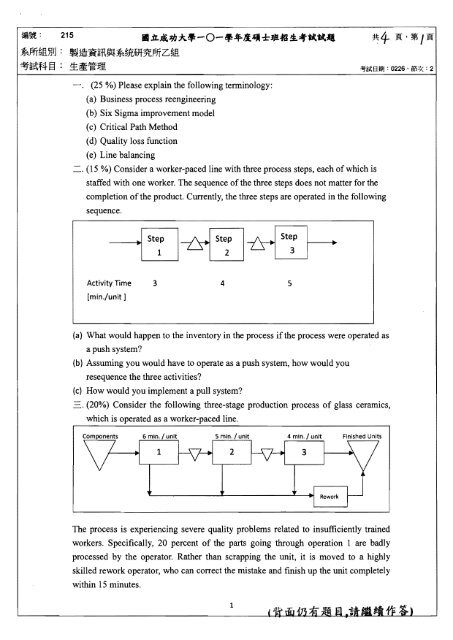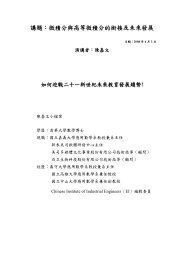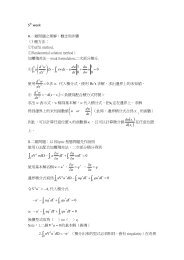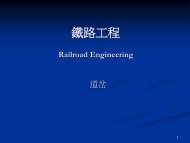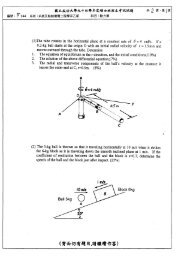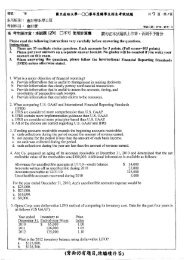Create successful ePaper yourself
Turn your PDF publications into a flip-book with our unique Google optimized e-Paper software.
215<br />
~PJTMi}jU:<br />
~~x~f1.~ ~MCtiff~pfi Z~Jl<br />
~~f4§: ~~~I!. ~~BWl : 0226 • il1i:x : 2<br />
-. (25 %) Please explain the following terminology:<br />
(a) Business process reengineering<br />
(b) <strong>Six</strong> <strong>Sigma</strong> <strong>improvement</strong> <strong>model</strong><br />
(c) Critical Path Method<br />
(d) Quality loss function<br />
(e) Line balancing<br />
=. (15 %) Consider a worker-paced line with three process steps, each of which is<br />
staffed with one worker. The sequence of the three steps does not matter for the<br />
completion ofthe product. Currently, the three steps are operated in the following<br />
sequence.<br />
Activity Time 3 4 5<br />
[min./unit 1<br />
(a) What would happen to the inventory in the process if the process were operated as<br />
a push system?<br />
(b) Assuming you would have to operate as a push system, how would you<br />
resequence the three activities?<br />
(c) How would you implement a pull system?<br />
(20%) Consider the following three-stage production process of glass ceramics,<br />
which is operated as a worker-paced line.<br />
6 min.! unit 5 min.! unit 4 min.! unit Finished Units<br />
1 2 3<br />
The process is experiencing severe quality problems related to insufficiently trained<br />
workers. Specifically, 20 percent of the parts going through operation 1 are badly<br />
processed by the operator. Rather than scrapping the unit, it is moved to a highly<br />
skilled rework operator, who can correct the mistake and finish up the unit completely<br />
within 15 minutes.<br />
1
ti.: 215 .jLJlsJJ:k.-O-....4"l-r*~!i.t(t(4<br />
~MM~g: ~••m.~.~~ffiZM<br />
:1f~f!j. § : 1:~~@' ""fiil:BWl : 0226· fI'j~ : 2<br />
The same problem occurs at station 2, where 10 percent of the parts are badly<br />
processed, requiring 10 minutes of rework. Station 3 also has a 10 percent ratio of<br />
badly processed parts, each of them requiring 5 minutes by the rework operator.<br />
(a) (6 %) What is the utilization of station 2 if work is released into the process at a<br />
rate of 5 units per hour?<br />
(b) (6 %) Where in the process is the bottleneck? Why?<br />
(c) (8 %) What is the process capacity?<br />
[7]. (40 %) (.~)<br />
1. Consider the all unit discount schedule. If a larger quantity is ordered,<br />
a. both the unit cost and total cost may decrease<br />
b. unit cost may decrease but the total cost increases<br />
c. both the unit cost and total cost may increase<br />
d. total cost may decrease but the unit cost increases<br />
2. The following are some characteristics of the EOQ <strong>model</strong> cost curve<br />
a. Total annual holding cost is the same as total annual ordering cost<br />
b. The total annual cost does not change much from the optimal value if the<br />
order quantity is near the EOQ value<br />
c. Both of the above<br />
d. None ofthe above<br />
3. Big Apple Appliances sells trendy electronic appliances in two different markets:<br />
New York and Chicago. Both the New York and Chicago markets have weekly<br />
demands that are normally distributed with means 200 and standard deviations 60.<br />
The demands in the two markets are positively correlated. Which of the following<br />
observations is definitely false?<br />
a. Week 1 and week 2 demands in the New York market were 200 and 400<br />
units. The demands in Chicago market over the same time periods were 400<br />
and 100 units, correspondingly.<br />
b. Average demand over the past 10 weeks in the two markets differs by 50<br />
units.<br />
c. Over the past 10 weeks, total demand in New York was 1500 units higher<br />
than the demand in the Chicago market.<br />
d. The coefficient of variation of the total demand from both the markets is<br />
0.15.<br />
e. The retailer sold more units in Chicago than in New York over the past<br />
several weeks.<br />
2
215<br />
~pff~Jl~U:<br />
~~JigRW~~jtuff~PJTZ*Jl<br />
~~f!f- § : 1:.~~l! ~ii\ BIOI: 0226 ' iSl:x : 2<br />
4, You are choosing between make-to-stock and make-to-order production modes for<br />
a new product. Which one of the following best supports the make-to-stock<br />
production choice?<br />
a. Customers are willing to wait for their orders.<br />
b. Competitors offer channel incentives.<br />
c. Demand for the product is smooth throughout the year.<br />
d. Components of the product are not well modularized.<br />
e. Cost of underage is much lower than cost ofoverage.<br />
S. Assume a firm implements an order up to inventory <strong>model</strong> with an order up-to<br />
level of 100. The lead time is 3 periods, demand is normally distributed and the<br />
target in-stock level is 99%. Which of the following will never be observed just<br />
after an order is placed?<br />
a. There are 80 units on-order.<br />
b. There are 90 units on-order and 7 units on-hand.<br />
c. 18 units were just ordered.<br />
d. There are 230 units backordered.<br />
e. None of the above.<br />
6. Some firms in the PC industry practice channel assembly. With channel assembly<br />
a supplier provides a distributor with approved parts, e.g., mother boards, disk<br />
drives, video cards, etc. The distributor then completes final assembly of the<br />
supplier's PC in response to actual demand. Before the implementation of channel<br />
assembly the distributor would merely hold finished goods inventory which the<br />
supplier assembled. This innovation is similar to<br />
a. Make-to-stock strategy (e.g., using the newsvendor <strong>model</strong>).<br />
b. Reactive capacity strategy.<br />
c. Assemble-to-order/direct-sale strategy.<br />
d. Postponement strategy.<br />
e. Mass customization strategy.<br />
7. Amazon started with one warehouse but now has seven warehouses. Amazon's<br />
decision to increase the number of warehouses it operates resulted in<br />
a. Higher overhead costs and lower technology costs.<br />
b. Higher service level and lower inventory costs.<br />
c. Higher inventory costs and lower shipping costs.<br />
d. None of the above.<br />
)
.!M: 215 .jL-'tljJAf:-O-f:.&.""-!:-J)141~.i(i(JI<br />
~PfT~]jU: ~~xnl.w.~f:5CEJT~pfTZ ~1l<br />
~~f4§: ~~~~ ~&i\81t1j : 0226· ru'i~ : 2<br />
8. Capacity pooling in the fonn of flexible capacity is most valuable when<br />
a. capacity is significantly greater than the expected demand.<br />
b. capacity is significantly smaller than the expected demand.<br />
c. capacity is approximately equal to the expected demand.<br />
d. the capacity size relative to demand does not matter.<br />
9. Which of the following is most accurate about revenue sharing in a supply chain<br />
with two finns, a retailer and a supplier?<br />
a. Revenue sharing shifts supply chain profit from the retailer to the supplier.<br />
b. Revenue sharing shifts supply chain profit from the supplier to the retailers.<br />
c. Revenue sharing is designed to improve response times in the supply chain.<br />
d. Revenue sharing is designed to improve forecasting within the supply chain.<br />
e. Revenue sharing is beneficial if increased product availability increases<br />
total supply chain profit.<br />
10. In the order up-to <strong>model</strong>, assume that the mean of demand in a period remains the<br />
same and the order up-to level is kept at a constant leveL If the demand<br />
uncertainty (the standard deviation of demand in each period) increases,<br />
a. the expected inventory at the end of each period would increase.<br />
b. the expected inventory at the end ofeach period would decrease.<br />
c. the expected inventory at the end ofeach period would remain unchanged.<br />
d. the expected inventory at the end ofeach period may go up or down.<br />
4


